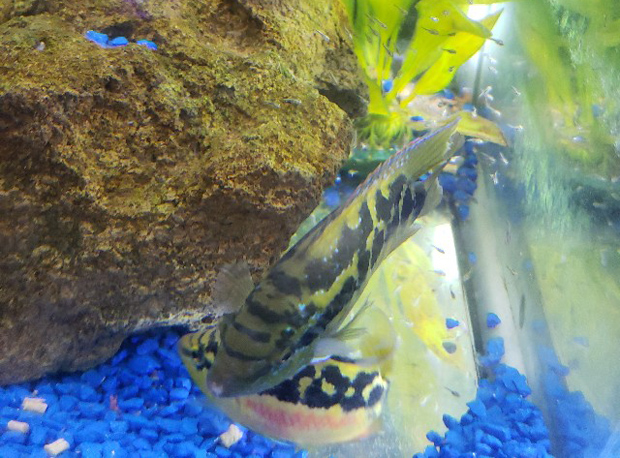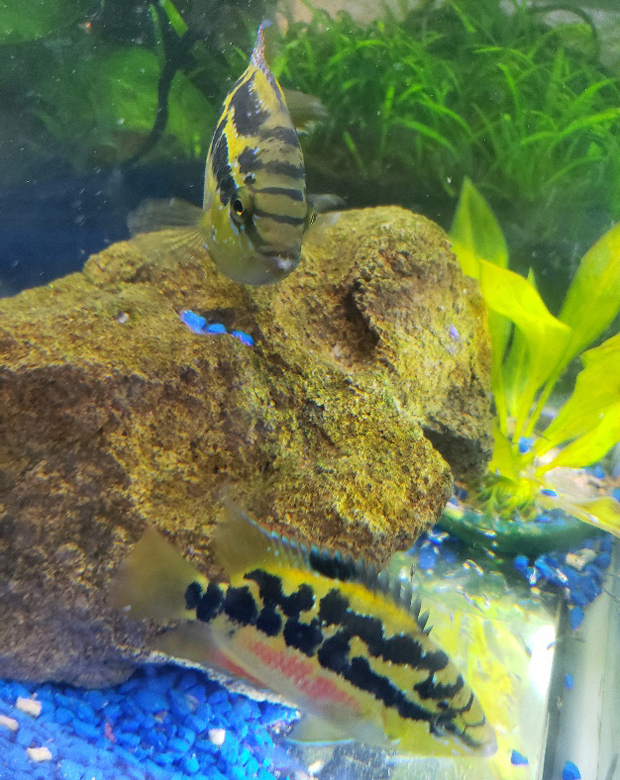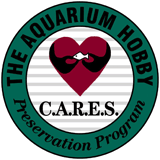Trichromis salvini
Günther 18621
The Yellow Belly Cichlid
BAP Report

Published 20211219
The yellow belly cichlid has been one of my favorite fish for over 50 years. I had my first pair in 1969 when I was a hard core-cichliophile. I was interested, primarily, in the Central and South American cichlids because of their pair bonding and fry raising behaviour as well as being a friend of Guy D. Jordan in San Diego2. As a result, I had a number of the "mid-size" cichlids of Central America before I took on the larger "guapotes."
Back then [in the 1970's] these fish were classified as Cichlasoma salvini, then a large group of similar cichlids that eventually was "reorganized" into various different genera, and it wasn't until 2015 the yellow belly cichlid was put into its own genus, Trichromis [representing the three primary colours of the fish] and being sufficiently different than other "Cichlasoma." Interestingly, it is closely related to another colourful Central American cichlid, the firemouth cichlid3. I originally got six one-inch fry in San Diego, California, and kept them in a growing [population wise] cichlid tank initially, and then they had several months of moving them to larger and larger tanks ending up with two pairs with a surplus female [unfortunately one of the males got into a tussle, and lost - and several days later succumbed to his wounds] and while the two pair had split a tank in half and weren't killing each other, I moved the smaller pair to a 50 gallon tank, slightly smaller than the 55 gallon they had been in. Back then, I had access to tubifex worms and lots of live brine shrimp [because I worked in a tropical fish store, so I got food at a reasonable price] plus I fed a mixture of beef heart, beef liver, flake food and some greens to my cichlids, which allowed for great growth.
Since I hadn't seen this species in a number of years I bought three fish - a male and two females from Lee's Feed in Shingle Springs, California. I put them into an empty 40-gallon breeder tank with some giant danios [Devario aequipinnatus]4 as dither fish to let them grow into mature fish, which being somewhere about six inches.

Trichromis salvini pair.
Unfortunately, one female decided she didn't like the other female, so she kept the other female in the upper rear left corner of the tank, allowing her about a 7 x 7 x 7 x 7 in area. Because of that aggression I put the 'pair' into a 55-gallon tank. Two clay pots were put into the tank plus some volcanic rock and a 3-foot piece of Manzanita wood. The pair settled down and pair bonding building continued or continued in earnest. After a while I had a pair, though I never saw any lip locking [biting] or any typical body language - they were shy when they saw me. The other female's fate was to be put into another 40-gallon tank with a colony of common kribensis - about twenty of them, plus a female Ameca spendens, a large leopard sword plant and other hardy plants. The yellow belly female immediately took refuge in a cave in a rear corner of the tank and stayed there, rarely coming out, and eventually died a lonely fish.
The pair in the 55-gallon got comfortable and positioned themselves by the rock - which had a cave structure - she down in the cave area and the male monitoring the rest of the tank from above the rock.
Nothing much happened for several months and several months of "just being there" while I fed them shrimp pellets, frozen brine shrimp and sometimes live bloodworms along with ground shrimp pellets, black soldier fly larvae [BSFL], and mosquito larvae. The female disappeared one morning, but there was no body. At the end of the tank where the clay pots were, she was between the two and acting very defensive as I tried to look for evidence of eggs or fry - there were none that I could see. The male was now patrolling from the clay pots on one end to the volcanic rock at the other - acting all tough when I would feed, or otherwise get close to the tank - even though the female was at least four feet from me and defending her clay pot.
After 3 days I spied tiny fry - so tiny I couldn't measure them [but I wasn't trying t hard to do that], so they must have been a little smaller than 1/32nd of an inch.
I mixed fry food with water [Golden Pearls and other fry foods] and used a baster to shoot the mixture down to the bottom where the fry were spending time together. The fry hovered around the clay pots and the female. Her cichlid language was forceful as she would tell the fry to either assemble behind/below her, or to disperse as I would try to look closely at the fry. The male was a little less tough as I continued to feed him and the giant danio's. The female refused food and the male loved the new food I was feeding - less roughly-ground [BSFL] and blood worms. For the blood worms, which I fed with a turkey baster, I would put the baster end two or more inches under the surface and shoot out the worms. He figured that out, so he started trying to get the worms that were at the tip, and sometimes he was able to bite the end and "suck" the worms out if I didn't immediately squirt them out.

Female Trichromis salvini with fry.
The fry stayed at the "other end" for about a month and then the pair moved the fry back to the volcanic rock from which they all could watch my approach, plus I suspect they were smart enough to figure out that it was better feeding area for the fry. The fry hung around the cave as the female was always in a defensive mode there.
Routine growth occurred with the fry and the pair would let the fry cloud grow and soon the fry were exploring to the middle of the tank in a swarm about the size of a basketball with the male in attendance as they looked for food in the sand and gravel. The fry grew on five hundred - 800-micron Golden Pearls, finely ground BSFL, crushed flake food and blood worms, graduating to crushed shrimp pellets or less finely ground BSFL and finely ground krill.
What I have always liked about this species was their colour pattern and relative peaceful cichlid behaviour. Unfortunately, the fish more than 50 years ago were better looking and colourful - brighter yellow and blues on their body and I often recommended them to customers when I worked in a local fish store.
They have two dark lines down the length of the body, one just above the distal tip of the pectoral fin, and the other just below the dorsal fin. They don't have large mouths because they don't prey on large fish - their diet in nature being more inclined to look for small invertebrates, aquatic insect larvae, and detritus - that's why I fed them the way I did. The overall body shape is oval or oblong. With usually 3 to 4 dark, narrow bars or lines from in between the eyes to the predorsal region anteriorly to the dorsal fin. Both sexes are colorful: yellow, red, blue, or sometimes greenish, and their colouration is more vivid during breeding, especially in the males where the red is often quite brilliant.
At some point, the female either died or was killed by the male - it happened "after hours" when I was not in the fish room and the lights were out in all but their fifty-five gallon. One day she was there and the next she was "gone." I looked high and low for her - on the floor, on the surface, and the next tank over - nothing. It was a mystery--then I found her under one of the outside curves of the larger flowerpot - I suspect the male chased her and she sought protection where she could, and either got trapped there and beaten upon, or stuck and couldn't wriggle her way out.
But the male did not harm the fry which were about ½ inch in size at that time. I then moved the young to an empty 40-gallon breeder tank and kept the male in the fifty gallon - and then got another female for him - luckily, Lees had a lone female and I brought her home. The male didn't care much for her so after a brief time in the 55-gallon, I relocated the female to a forty gallon with a medium sized [14-inch assassin pleco [despite that appellation, is a peaceful giant]. After reacclimating to less stress, she then went in with the growing fry which she did not bother - probably because I use the philosophy of the more there are, the less the aggression. After a month of that arrangement, with 3-4 water changes per week--so I could eliminate growth inhibiting substances [GIS] exuded by more dominant fish--I threw the lot into the fifty-five with the male and giant danios where they resided until I brought in a BAP batch and also traded others.
It was fun to get back into medium sized cichlids again, and I look forward to another return to a mid-sized cichlid to watch and breed.
For further information and reading:
Conkel, D. 1993. Cichlids of North and Central America. T. F. H. Publications, Inc., Neptune City, New Jersey.
Eschmeyer, W. N., R. Fricke, and R. van der Laan, editors. 2018. Catalog of fishes: genera, species, references. Accessed November 22. 2021.
Froese, R., and D. Pauly, editors. 2018. Trichromis salvini [Günther, 1862]. FishBase. Available: https://www.fishbase.de/summary/Trichromis-salvini.html accessed November 22. 2021.
1 Named in honour of Obert Salvin, an English naturalist, ornithologist, and herpetologist best known for co-authoring Biologia Centrali-Americana along with Frederick DuCane Godman
2 Guy D. Jordan, Jr., was the First Fellow of the American Cichlid Association due to his stewardship, guiding and growing the ACA from a small group of enthusiasts when Dick Stratton, the major initiator of the formation was busy being a teacher, while Guy, though being legally blind, had bot time and n extensive communication network with professionals and hobbyists the world over, which helped the ACA grow, whether they were interested in cichlids, or the hobby, and took beginners like myself under his wing.
3 So named because of its red belly-to-mouth colouration.
4 Giant Danios make excellent dither fish for most American Cichlids.

